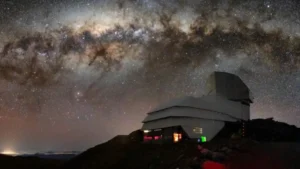These are delicate, stressful times, and I know that if you read a sentence like “a chunk of the sun broke off and is flying around in a huge cyclone around its north pole, and no one knows why,” your blood pressure is going to tick up a few notches.
I normally wouldn’t do you like that. But as a journalist, I’m obliged to report the news as it happens. So, sorry about this:
A chunk of the sun broke off and is flying around in a huge cyclone around its north pole, and no one knows why.
Dr. Tamitha Skov, a “space weather forecaster” and an as-seen-on-the-History-Channel scientist, shared a video of the phenomenon on Twitter. The footage, captured by NASA’s Solar Dynamics Observatory, clearly shows solar plasma breaking away from a “prominence” near the sun’s 55-degree latitude. After separating from the main strand, the plasma filament circles the sun’s north pole in a truly impressive nuclear-powered vortex.
“Implications for understanding the sun’s atmospheric dynamics above 55° here cannot be overstated!” Skov gushed in her Tweet.
Talk about Polar Vortex! Material from a northern prominence just broke away from the main filament & is now circulating in a massive polar vortex around the north pole of our Star. Implications for understanding the Sun’s atmospheric dynamics above 55° here cannot be overstated! pic.twitter.com/1SKhunaXvP
— Dr. Tamitha Skov (@TamithaSkov) February 2, 2023
Solar cycles
If it helps you feel any better, the phenomenon is part of a series of events that repeat every 11 years, though nobody’s ever seen it quite like this.
“Once every solar cycle, [the solar prominence] forms at the 55-degree latitude and it starts to march up to the solar poles,” Scott McIntosh, a solar physicist and deputy director of the National Center for Atmospheric Research, told Space.com. “It’s very curious. There is a big ‘why’ question around it. Why does it only move toward the pole one time and then disappear and then come back, magically, three or four years later in exactly the same region?”‘

Nobody knows exactly why this happens, partly because the sun’s polar regions are hard to study. Photo: Screenshot
In the past, observers have noticed strands of plasma detach from the prominence. But nobody’s ever seen such a colossal chunk break off, much less fly around the sun’s north pole.
A ‘chilling’ prediction
Events at the sun’s poles are hard to study, according to Space.com. That’s because the Earth orbits the sun in a fixed plane, which limits our observations of the sun’s northern and southern latitudes.
An upcoming European Space Agency (ESA) Solar Orbiter mission may provide a few clues as to the plasma vortex, but Space.com points out that McIntosh isn’t super optimistic. In any case, the sun will hit the most active phase of its 11-year cycle in 2024. So we can probably expect more solar light shows as the year progresses.
Meanwhile, the editors at the Daily Mail would like to remind you that a 2022 ESA mission resulted in a “chilling prediction that our sun is almost halfway through its life span.”
If true, that leaves you a mere five billion years to get your affairs in order.






